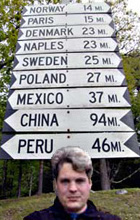Subscribe to the blog 
|
 |
 |
 |
 |
 |
Find a Flight Consider a Consolidator Rent a Car Pick a Railpass Book a Vacation Reserve a Room Get Gear |
|
||||||
|
Endangering Our National Parks: An Editorial (cont'd) << back "So far," says Vera Smith, Conservation Director of the Colorado Mountain Club. "The outsourcing studies have diverted millions of dollars-dollars that should have been spend on managing wildlife, maintaining facilities, and helping visitors-to confirm that federal land managers are, in fact, doing a good job." Not only are the park workers already doing a good job maintaining our 338 National Parks, Monuments, and Recreation Areas-natural wonderlands and historic monuments that are enjoyed by some 280 million visitors, tourists, and campers each year. They're also maintaining the engines of economic growth in local tourism industries across the nation. PARKS ARE GOOD BUSINESS "California National Parks are both environmental and economic treasures," said Senator Barbara Boxer, endorsing the National Parks Conservation Association Nov 6 report on the economic impact of California's 23 National Parks. "They not only provide respite from our busy lives, they also make important contributions to our economy." "Important contributions" may be an understatement. The report found that those 23 parks bring $1.18 billion a year into the state and local economies, providing for 30,000 private sector jobs. That's 30,000 jobs in addition to the folks working for the National Park Service. Heck, if you take just the state's ten most popular parks in 2001—a year when travel numbers everywhere took a major nosedive in the final four months—the top ten still drew 11 million visitors. Those visitors pumped $642 million into the local coffers, and supported nearly 17,000 jobs. We're talking the maids in the local motels and the old guy who runs the coffee shop on Main Street in the town just outside the park gates. These tourism boom towns draw in new blood for the community (think of that laid-back, dreadlocked 22 year old who leads river rafting trips) and wads of cash for local coffers. The LA Times article cited above points to Scott Munger's seven-room B&B in Lemon Cove, a 190-person hamlet high in the Sierra Nevada. This tiny inn in the middle of nowhere is nonetheless booked solid by 3,500 people each year—because 16 miles up the road lie the entrances to Sequoia and King's Canyons parks. "This report confirms what we have long known intuitively, that California's National Parks are not merely natural wonders, but are integral to our quality of life and state economy," said Sen. Diane Feinstein. "By taking good care of these special places and providing park visitors with a quality experience, we sustain jobs and support our tourism economy while also protecting our natural and cultural heritage. It's a win-win situation." more >> |

